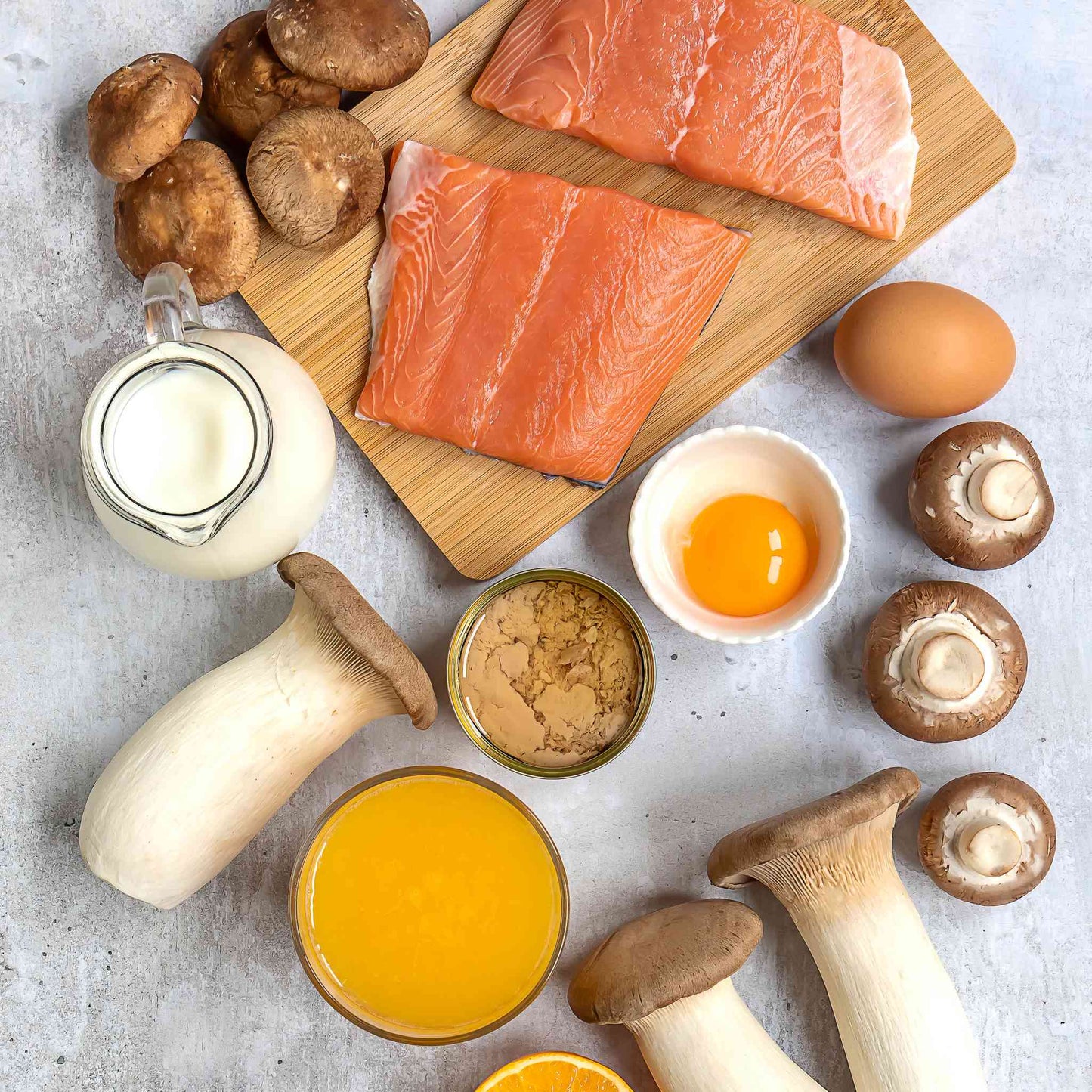
“Only those who will risk going too far can possibly find out how far one can go.”
— T.S. Eliot
Think of vitamin D as studying, while vitamin D2 (ergocalciferol) and D3 (cholecalciferol) as learning techniques.
Studying helps you understand a subject, but some learning techniques are more effective than others in making you comprehend a topic. For example, you're better off learning actively [teaching what you learn] than passively [reading your notes] to put knowledge in your long-term memory.
In the case of vitamin D foods and supplements, both of their main forms increase your vitamin D levels and improve your immune system. However, in terms of effectiveness, vitamin D3 wins against vitamin D2.
In this blog, you'll discover not only why vitamin D3 is more effective than D2 but also how the vitamins differ in their formation and food and supplement sources.
But before that, let’s have a refresher about why you need to take vitamin D daily.

Role of Vitamin D in Your Body
“Almost everything will work again if you unplug it for a few minutes, including you.” — Anne Lamott
Although different vitamins have similar benefits, they have their main functions. With regards to vitamin D, it’s responsible for maintaining normal blood levels of calcium and phosphorus [1].
Speaking of calcium, vitamin D also plays a crucial role in strengthening your bones by helping the body absorb this mineral.
This means you’ll have weaker bones and muscles if you’re vitamin D deficient. You’ll also be more prone to diseases, as a lack of vitamin D leads to a lower immune system.
3 Differences Between Vitamin D2 and D3
“In order to be irreplaceable one must always be different.”
— Coco Chanel
The difference between both forms of vitamin D is more than just “D2” and “D3.” The following are the three differences between vitamin D2 and D3 you need to know, especially if you’re considering buying vitamin D or nootropic supplements that include the vitamin D3):
1. Formation
Let’s start off with the similarity of forming vitamin D2 and D3. Both are formed due to a type of UV radiation from the sun called UVB — The Skin Care Foundation states that it’s UBV, not UVA, that helps the skin make vitamin D [2].
Plants form vitamin D2. Human and animal skin, on the other hand, are the ones that create vitamin D3.
Vitamin D2 is formed when the provitamin D2 (ergosterol) of fungi, like mushrooms and yeasts, is converted into vitamin D after exposure to UV light.
Regarding vitamin D3, its process starts when the human or animal skin’s provitamin D3 (7-dehydrocholesterol) absorbs UVB radiation, turning the provitamin into vitamin D3.
Your body’s ability to make vitamin D because of the sun is why sunlight is known as the “sunshine vitamin.” Ideally, you should have around 10 to 30 minutes of sunlight during the morning or midday. However, if you have dark skin, you have more melanin, which means you need more time to get enough vitamin D from the sun.
There are other things you have to consider when getting vitamin D from the sun other than duration, such as:
- Wearing Light Shirts: Clothes with light materials and colors block fewer UVB rays.
- Using Sunscreen: It doesn't cause vitamin D deficiency.
- Drinking Water or Milk: Helps with boosting your vitamin D absorption.
2. Food and Supplement Source
With the knowledge about the formation of vitamin D2 and D3 in mind, you might have guessed how they’ll differ in the food and supplement source.
But to clarify, the vitamin D you get from animal-based sources is vitamin D3, while the vitamin D you get from plant-based sources is vitamin D2.
According to WebMD, the following are foods with vitamin D3 [3]:
- Rainbow Trout (645 IU)
- Sockeye Salmon (570 IU)
- Sardines (200 IU)
- Egg (44 IU)
- Beef Liver (42 IU)
By the way, fish don’t get vitamin D3 from the sun. Instead, they get it from their diet by eating plankton. [4]

Regarding vitamin D2, though, it’s worth noting that even vitamin D in plants is rare. In fact, the only known plant-based source of vitamin D is mushrooms that have been exposed to sunlight or other ultraviolet (UV) light sources. Lion’s mane is an example of a mushroom that has not only high vitamin D but also protein. Just a caveat, not all wild mushrooms are safe to eat.
UV radiation sources, like sunlight and UV lamps, are crucial in mushrooms creating vitamin D2. Because without UV light, the provitamin D2 from mushrooms won’t be converted into vitamin D2. [5]
But besides mushrooms, you can find vitamin D2 in numerous fortified foods that contain yeast. Some examples are oatmeal, cereals, and bread — the reason why vitamin D2 is often added in fortified foods more than vitamin D3 boils down to cost-effectiveness.
Now, about vitamin D2 supplements, they’re derived from yeast. Vitamin D3, on the other hand, is sourced from lanolin found in sheep’s wool.
Don’t lose hope with vitamin D3 supplements if you’re a vegan, though, as there are now supplements containing vitamin D3 that are vegan-friendly, like Maximum Mind, which uses lichen (a plant-based source) for vitamin D3.
3. Effectiveness
While both forms of vitamin D increase the vitamin D in your blood, it’s been proven by numerous studies, like from The American Journal of Clinical Nutrition, that vitamin D3 does a better job than vitamin D2 [6].
And according to researchers at the Universities of Surrey and Brighton, Vitamin D3 has also been found to be more effective in improving your immune system than vitamin D2 [7].
This explains why healthcare experts recommend you take vitamin D3 supplements instead to maximize the benefits you get [8].
But besides knowing the effectiveness, you should also consider the following before buying supplements:
- Choose supplements that contain non-GMO or organic ingredients to avoid toxic chemicals.
- Realize that a poor diet makes taking supplements pointless.
- Learn how to read supplement labels for a better understanding of what you’re putting in your body.
- Refrain from taking too many supplements to avoid overdosing.
- Consult with a certified healthcare professional if you’re currently taking medications.

Conclusion
"An end is only a beginning in disguise."
— Craig D. Lounsbrough
The two forms of vitamin D supplements are vitamin D2 and D3. The former is found in plant-based foods, like mushrooms and yeasts, while the latter can be seen in animal-based foods, like fish and meat. The same goes for their formation.
Vitamin D2 is formed in plants, while vitamin D3 forms in animal skin. It’s also vitamin D3 that your body produces when your skin is exposed to sunlight.
When sourcing for supplements, vitamin D2 supplements get it from yeast, and vitamin D3 supplements obtain it from the lanolin in sheep’s wool. However, it’s worth mentioning that some vitamin D3 supplements can make their product vegan-friendly by using lichen instead.
You’d get your money’s worth if you choose vitamin D3 supplements since it’s more effective in increasing your vitamin D levels and boosting your immune system.
As mentioned a while ago, Maximum Mind uses lichen to get vitamin D3, making it a vegan-friendly supplement. It also contains lion’s mane mushroom, which is another source of vitamin D. However, that’s not the only benefit you’ll get if you buy Maximum Mind. It also provides other beneficial ingredients that will help improve your mental performance to make you become the best version of yourself.
Sources
- BSPharm, Y. C. T., RPh. (2021, March 8). The Important Role of Vitamin D. Pharmacy Times.
- The Skin Cancer Foundation. (2020). Sun Protection and Vitamin D. The Skin Cancer Foundation.
- WebMD Editorial Contributors. (2020, November 9). Foods High in Vitamin D3. WebMD.
- Do All Animals Receive Vitamin D From the Sun? (2020, November 19). Pets on Mom.com.
- Nölle, N., Argyropoulos, D., Ambacher, S., Müller, J., & Biesalski, H. K. (2017). Vitamin D2 enrichment in mushrooms by natural or artificial UV-light during drying. Lebensmittel-Wissenschaft & Technologie, 85, 400–404.
- Tripkovic, L., Lambert, H., Hart, K., Smith, C. P., Bucca, G., Penson, S., Chope, G., Hyppönen, E., Berry, J., Vieth, R., & Lanham-New, S. (2012). Comparison of vitamin D2 and vitamin D3 supplementation in raising serum 25-hydroxyvitamin D status: a systematic review and meta-analysis. The American journal of clinical nutrition, 95(6), 1357–1364.
- Study questions the role of vitamin D2 in human health but its sibling, vitamin D3, could be important for fighting infections | University of Surrey. (n.d.).
- Mindbodygreen. (2021b, November 12). I’m a PhD & RD: I Want You To Stop Making This Vitamin D Mistake ASAP. Mindbodygreen.
